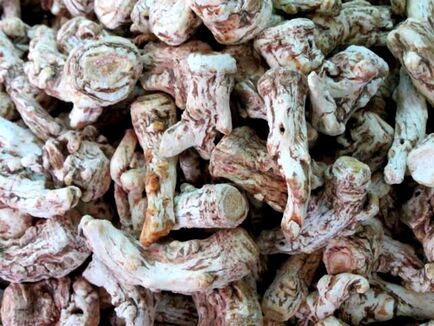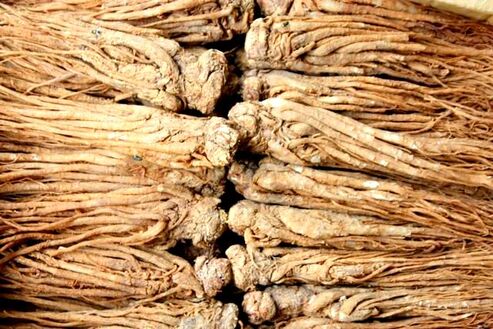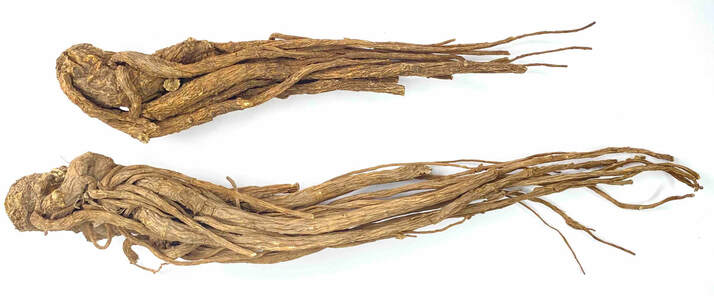Sentry Page Protection
A. polymorpha var. chinensis (=A. sinensis)
Hooker, Icones Plantarum, 1891
Hooker, Icones Plantarum, 1891
Two different types of Dang Gui available on the Chinese Market. Left is the dried root with head and rootlets removed;
Right is the whole root with head and rootlets and which has been lightly steamed with alcohol before drying.
(Adam, 2015, 2016)
Right is the whole root with head and rootlets and which has been lightly steamed with alcohol before drying.
(Adam, 2015, 2016)
Whole Angelica Dang Gui roots (Adam, 2024)
Botanical name:
Angelica spp.
Parts used:
Root
Temperature & Taste:
Warm, slightly moist. Sweet, Pungent
Classifications:
N. Blood Tonic
Angelica spp.
- A. sinensis (syn. A. polymorpha var. sinensis) (China)
- A. acutiloba (Japan)
Parts used:
Root
Temperature & Taste:
Warm, slightly moist. Sweet, Pungent
Classifications:
N. Blood Tonic
Uses:
1. Nourish the Blood, Regulates Menstruation:
-amenorrhea and dysmenorrhea; a main herb in TCM for Menstrual disorders
-blood deficiency syndrome, anemia, pernicious anemia
-skin diseases, eczema, dermatitis, neurodermatitis, psoriasis (with blood deficiency)
-sores, abscess with blood deficiency
-restores heat in the lower body (Tibet)
2. Moves the Blood, Eases Pain:
-important for Gynecological and Postpartum diseases with Blood stasis
-'very important drug in treating postpartum diseases'; (Chen Cheng)
-thrombophlebitis, neuralgia, arthritis
-chronic nephritis, constrictive aortitis, hepatitis, Raynaud’s disease
-pain due to blood stasis, trauma, bruising
3. Moisten the Intestines, Promote Stool:
-good to move the bowels in dryness, weakness or blood deficiency
-has an opening effect similar to the Opening Roots
4. Reduces Swelling, Promotes Healing:
-sores and abscesses that are slow-to-heal due to poor circulation
5. Clears Wind-Cold:
-'good for all diseases caused by invasion of pathogenic Wind'. (Da Ming)
-can be used for Wind-type Headache
-this is not a modern indication but shows a relation to Western Angelica and Angelica Bai Zhi
Dose:
Decoction: 4–12 grams
Powder: 1–3 grams
Comment:
Different parts of the Root have different functions traditionally:
1. The Head is most tonifying and is called Dang Gui Tou; but its blood-moving effect is weak.
2. The fine lateral roots are called Dang Gui tail (Dang Gui Wei). They are stronger to move Blood, but less tonifying.
3. The main body of the root has both aspects, tonifying and activating, being slightly more tonifying.
4. 'Dang Gui produced in Sichuan is strong in function and can be used in the dispersion of pathological conditions. That produced in Qinzhou is mild in function and can thus be used as a toni'c' (Han Mao). This again shows a strong dispersing nature in Dang Gui which is associated with its pungent taste. Stronger types such as that found wild can also be used for dispersing external Wind-Cold disease.
Preparation:
1. Stir-fried Dang Gui:
Stir-fried until yellow or lightly scorched removes the laxative effect; it is good for menstrual disorders with Diarrhea.
2. Wine-prepared Dang Gui:
Prepared with Wine, it is stronger to enter the Blood and clear stasis (this is called Jiu Xi Dang Gui).
3. Ginger-prepared Dang Gui:
The root may be prepared with Ginger in a couple of variations. The fresh juice of ginger can be sprinkle on the Dang Gui roots which are then baked or lightly dry-fried. Alternatively, a strong decoction of fresh Ginger may be prepared, and the Dang Gui roots are soaked in overnight, then removed and dried in the sun the following day, or else baked.
This is especially useful for dispersing Phlegm stagnation, but can also be used for acute Wind-Cold diseases. It also has the benefit of harmonising the Stomach.
4. Charred Dang Gui:
Like various other Blood herbs, Dang Gui can be charred until blackish on the outside but still yellow inside to stop Bleeding.
Decoction: 4–12 grams
Powder: 1–3 grams
Comment:
Different parts of the Root have different functions traditionally:
1. The Head is most tonifying and is called Dang Gui Tou; but its blood-moving effect is weak.
2. The fine lateral roots are called Dang Gui tail (Dang Gui Wei). They are stronger to move Blood, but less tonifying.
3. The main body of the root has both aspects, tonifying and activating, being slightly more tonifying.
4. 'Dang Gui produced in Sichuan is strong in function and can be used in the dispersion of pathological conditions. That produced in Qinzhou is mild in function and can thus be used as a toni'c' (Han Mao). This again shows a strong dispersing nature in Dang Gui which is associated with its pungent taste. Stronger types such as that found wild can also be used for dispersing external Wind-Cold disease.
Preparation:
1. Stir-fried Dang Gui:
Stir-fried until yellow or lightly scorched removes the laxative effect; it is good for menstrual disorders with Diarrhea.
2. Wine-prepared Dang Gui:
Prepared with Wine, it is stronger to enter the Blood and clear stasis (this is called Jiu Xi Dang Gui).
3. Ginger-prepared Dang Gui:
The root may be prepared with Ginger in a couple of variations. The fresh juice of ginger can be sprinkle on the Dang Gui roots which are then baked or lightly dry-fried. Alternatively, a strong decoction of fresh Ginger may be prepared, and the Dang Gui roots are soaked in overnight, then removed and dried in the sun the following day, or else baked.
This is especially useful for dispersing Phlegm stagnation, but can also be used for acute Wind-Cold diseases. It also has the benefit of harmonising the Stomach.
4. Charred Dang Gui:
Like various other Blood herbs, Dang Gui can be charred until blackish on the outside but still yellow inside to stop Bleeding.
Main Combinations:
Blood Tonic:
1. Weakness, Debility, Fatigue
i. Angelica Dang Gui is often combined with Astragalus Huang Qi. This potent combination strengthen Qi and Blood; good for debility, fatigue, excess blood loss. A large dose of Huang Qi (30 grams) is often used with Dang Gui (6–9 grams). (This forms Dang Gui Bu Xue Tang)
ii. stronger than the preceding, Angelica Dang Gui, Astragalus Huang Qi, Ginseng (from Wang Haogu)
iii. Qi and Blood deficiency, Angelica Dang Gui with Codonopsis Dang Shen, Atractylodes Bia Zhu, Paeonia Bai Shao, Poria Fu Ling, Licorice (as in Ba Zhen Tang)
Gynecology & Obstetrics:
2. Menstrual irregularity, Amenorrhea, Dysmenorrhea associated with Blood deficiency or Blood stasis, Angelica Dang Gui with Rehmannia Shu Di Huang, Paeonia Bai Shao and Ligusticum Chuan Xiong (as in Four Substance Decoction, Si Wu Tang)
– Blood stasis or Blood deficiency but with signs of Heat, add Paeonia Mu Dan Pi and Coptis Huang Lian to Si Wi Tang (above).
– More pronounced Blood stasis with fixed pain, cyanosis of the lips and nail beds, and dark, clotted menstrual blood, add Safflower (Hong Hua) and Peach kernel (Tao Ren) to Si Wu Tang (above) to make Tao Hong Si Wu Tang.
3. Dysmenorrhea, Angelica Dang Gui with Cyperus rotundus. If the pain is severe, add Corydalis Yan Hu Suo.
4. Irregular Uterine Bleeding with signs of Blood Stasis, Angelica Dang Gui with Lotus Stamen (Lian Xu), Safflower (Hong Hua)
5. Infertility from Blood and Essence deficiency, Angelica Dang Gui with Cistanche Rou Cong Rong, Deer horn Gelatin (Lu Jiao Jiao) and prepared Placenta Zi He Cao.
6. Abdominal pain and Diarrhea during pregnancy, Angelica Dang Gui with Paeonia Bai Shao and Poria Fu Ling.
7. Threatened Miscarriage, Angelica Dang Gui with Rehmannia Shu Di Huang, Ziziphus Suan Zao Ren and Lotus Receptacle Lian Fang
8. Postpartum deficiency, Angelica Dang Gui with Cinnamon twig Gui Zhi, fresh Ginger root and Lamb, cooked as a soup.
9. Menopausal hot flushes, insomnia and fatigue, Dang Gui with Camomile (Matricaria) (proven effect)
Blood Stasis, Pain:
10. Trauma, Bruising, Fixed, stabbing pain, Fractures:
i. Angelica Dang Gui with Salvia Dan Shen, Myrrh and Frankincense (as in Huo Luo Xiao Ling Dan)
ii. Angelica Dang Gui with Ligusticum Chuan Xiong, Myrrh (Mo Yao), Corydalis Yan Hu Suo
iii. Angelica Dang Gui with Ligusticum Chuan Xiong, Paeonia Chi Shao Yao, Peach kernel Tao Ren, Safflower Hong Hua, Earthworm Di Long (as in Bu Yang Huan Wu Tang)
iv. to activate Blood and resolve stasis, Dang Gui, Rhubarb (Da Huang), Pharbitis Qian Niu Zi (from Wang Haogu)
11. Wind-Damp joint pain, Angelica Dang Gui with Gentiana Qin Jiao, Gastrodia Tian Ma, Notopterygium Qian Huo, Ligusticum Chuan Xiong (as in Qin Jiao Tian Ma Tang)
Other:
12. Heat in the Blood, Dang Gui, Rehmannia Sheng Di Huang, Scutellaria Huang Qin (from Han Mao)
13. Insomnia, Irritability, Palpitations:
i. Angelica Dang Gui with Paeonia Bai Shao, Polygonum He Shou Wu
ii. Angelica Dang Gui with Ziziphus Semen Suan Zao Ren, Platycladus Bai Zi Ren, Poria Sclerotium Fu Shen (as in Yang Xin Tang)
14. Stroke with Hemiplegia, Numbness, loss of Speech, Angelica Dang Gui with, Ligusticum Chuan Xiong, Peach kernel (Tao Ren), Safflower (Hong Hua), Trachelospermum Luo Shi Teng, Earthworm, Scorpion (as in Zhong Feng Hui Chu Wan)
15. Constipation from dryness and weakness:
i. combine Angelica Dang Gui with Cannabis seed or Sesame seed.
ii. with Blood stagnation, Angelica Dang Gui with Peach kernel (Tao Ren)
16. Sores, Abscesses and Toxic Swellings, Angelica Dang Gui with Figwort (Xuan Shen) or Burdock seed (Niu Bang Zi).
Major Formulas:
Cautions:
1. Not used in Diarrhea or loose stool from Spleen deficiency.
2. Research has demonstrated a tumurogenic effect on Breast Cancer cells (see here). However, other population-based research showed a weak but significant protective effect against Breast Cancer (see here). The use of Dang Gui in Breast Cancer remains controversial with various sources recommending Dang Gui should not be used in Breast Cancer. As a component of larger formulas in Breast Cancer treatment it probably poses no risk but offers several benefits.
Drug Interactions:
Dang Gui may potentiate Blood thinners (in large doses).
No negative interaction with Aspirin was found (see here)
Main Preparations used:
1. Not used in Diarrhea or loose stool from Spleen deficiency.
2. Research has demonstrated a tumurogenic effect on Breast Cancer cells (see here). However, other population-based research showed a weak but significant protective effect against Breast Cancer (see here). The use of Dang Gui in Breast Cancer remains controversial with various sources recommending Dang Gui should not be used in Breast Cancer. As a component of larger formulas in Breast Cancer treatment it probably poses no risk but offers several benefits.
Drug Interactions:
Dang Gui may potentiate Blood thinners (in large doses).
No negative interaction with Aspirin was found (see here)
Main Preparations used:
Click the Tabs above for more information on this Medicine




